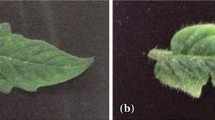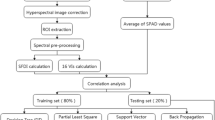Abstract
Spectral screening can play an important role in successful detection of viroid-infected oil palm seedlings from nursery stage prior to transplanting into the field. Coconut cadang–cadang viroid (CCCVd) is the main causal agent of orange spotting (OS) disease. OS disease is an emerging disease in Malaysian plantation. In this study, a glasshouse experiment was conducted with fifteen CCCVd-inoculated and five healthy oil palm seedlings in the growing season of 2015. Spectral screening was performed using a hyperspectral spectroradiometer, Analytic Spectral Device HandHeld 2 (325–1075 nm). The red edge, a steep gradient in reflectance between red and near-infrared bands (680–780 nm), was used for selection of red edge bands. A maximum point (i.e., 700 nm) and minimum point (i.e., 768 nm) of red edge were selected from healthy and inoculated spectra. Shifts of red edge inflection point from healthy to inoculated spectra were also studied. Four well-known spectral indices, namely simple ratio, red edge normalized difference vegetation index, two-band enhanced vegetation index 2 (EVI2), and chlorophyll index red edge, were evaluated using selected red edge bands. The multilayer perceptron neural network model was used to establish a nonlinear relationship between selected spectral bands and each spectral index. EVI2 was selected as a best spectral index which resulted in zero errors at the training, testing, and validation datasets. The highest coefficient of correlation (r = 1) was recorded between spectral bands (input values) and EVI2 (target values).



Similar content being viewed by others
References
ASD. (2010). FieldSpec ® Handheld 2 user manual. Boulder: ASD Inc. www.asdi.com. Accessed 5 Nov 2017.
Behmann, J., Steinrücken, J., & Plümer, L. (2014). Detection of early plant stress responses in hyperspectral images. ISPRS Journal of Photogrammetry and Remote Sensing, 93, 98–111. https://doi.org/10.1016/j.isprsjprs.2014.03.016.
Blackburn, G. A. (1998). Quantifying chlorophylls and caroteniods at leaf and canopy scales: An evaluation of some hyperspectral approaches. Remote Sensing of Environment, 66(3), 273–285.
Bürling, K., Hunsche, M., & Noga, G. (2011). Use of blue–green and chlorophyll fluorescence measurements for differentiation between nitrogen deficiency and pathogen infection in winter wheat. Journal of Plant Physiology, 168(14), 1641–1648.
Datt, B. (1999). A new reflectance index for remote sensing of chlorophyll content in higher plants: tests using eucalyptus leaves. Journal of Plant Physiology, 154(1), 30–36. https://doi.org/10.1016/S0176-1617(99)80314-9.
Delegido, J., Verrelst, J., Meza, C. M., Rivera, J. P., Alonso, L., & Moreno, J. (2013). A red-edge spectral index for remote sensing estimation of green LAI over agroecosystems. European Journal of Agronomy, 46, 42–52. https://doi.org/10.1016/j.eja.2012.12.001.
Dixit, L., & Ram, S. (1985). Quantitative analysis by derivative electronic spectroscopy. Applied Spectroscopy Reviews, 21, 311–418.
Forde, S. C. M., & Leyritz, M. J. P. (1968). A study of confluent orange spotting of the oil palm in Nigeria. Journal of Nigerian Institute of Oil Palm Research, 4, 371–380.
Gilabert, M. A., Gandía, S., & Meliá, J. (1996). Analyses of spectral-biophysical relationships for a corn canopy. Remote Sensing of Environment, 55(1), 11–20. https://doi.org/10.1016/0034-4257(95)00187-5.
Gitelson, A. A., Keydan, G. P., & Merzlyak, M. N. (2006). Three-band model for noninvasive estimation of chlorophyll, carotenoids, and anthocyanin contents in higher plant leaves. Geophysical Research Letters, 33(11), L11402.
Haseloff, J., & Symons, R. H. (1982). Comparative sequence and structure of viroid-like RNAs of two plant viruses. Nucleic Acids Research, 10(12), 3681–3691.
Horler, D. N. H., Dockray, M., & Barber, J. (1983). The red edge of plant leaf reflectance. International Journal of Remote Sensing, 4(2), 273–288. https://doi.org/10.1080/01431168308948546.
Huete, A., Didan, K., Miura, T., Rodriguez, E. P., Gao, X., & Ferreira, L. G. (2002). Overview of the radiometric and biophysical performance of the MODIS vegetation indices. Remote Sensing of Environment, 83(1), 195–213.
Huete, A. R., Liu, H. Q., Batchily, K., & Van Leeuwen, W. (1997). A comparison of vegetation indices over a global set of TM images for EOS-MODIS. Remote Sensing of Environment, 59(3), 440–451.
Imperial, J. S., Bautista, R. M., & Randles, J. W. (1985). Transmission of the coconut cadang–cadang viroid to six species of palm by inoculation with nucleic acid extracts. Plant Pathology, 34(3), 391–401.
Izzuddin, M. A., Idris, A. S., Nisfariza, N. M., & Ezzati, B. (2015). Spectral based analysis of airborne hyperspectral remote sensing image for detection of ganoderma disease in oil palm. In Int’l Conference on Biological and Environmental Science (BIOES 2015) (pp. 13–20).
Jiang, Z., Huete, A. R., Didan, K., & Miura, T. (2008). Development of a two-band Enhanced Vegetation Index without a blue band. Remote Sensing of Environment, 112(10), 3833–3845.
Jordan, C. F. (1969). Derivation of leaf-area index from quality of light on the forest floor. Ecology, 50(4), 663–666. https://doi.org/10.2307/1936256.
Joseph, H. (2012). Characterization and pathogenicity of coconut cadang–cadang viroid variants in oil palm (Elaeis guineensis Jacq.) seedlings. Ph.D. Thesis. Universiti Putra Malaysia, Serdang.
Kumar, L., Schmidt, K., Dury, S., & Skidmore, A. (2002). Imaging spectrometry and vegetation science. In F. D. Van der Meer, & S. M. D. Jong (Eds.), Imaging spectrometry (pp. 111–155). Berlin: Springer.
Mahlein, A.-K., Oerke, E.-C., Steiner, U., & Dehne, H.-W. (2012). Recent advances in sensing plant diseases for precision crop protection. European Journal of Plant Pathology, 133(1), 197–209. https://doi.org/10.1007/s10658-011-9878-z.
MPOB. (2016). Overview of the Malaysian oil palm industry 2016. http://bepi.mpob.gov.my/images/overview/Overview_of_Industry_2016.pdf. Accessed on 17 December 2017.
MPOC. (2012). Malaysian palm oil industry: One of the world’s largest palm oil exporter. http://www.mpoc.org.my/Malaysian_Palm_Oil_Industry.aspx. Accessed on 15 April 2016.
Noujdina, N. V., & Ustin, S. L. (2008). Mapping downy brome (Bromus tectorum) using multidate AVIRIS data. Weed Science, 56(1), 173–179.
Numata, I. (2011). Characterization on pastures using field and imaging spectrometers. In P. S. Thenkabail, J. G. Lyon, & A. Huete (Eds.), Hyperspectral Remote Sensing of Vegetation (pp. 207–226). Boca Raton: CRC Press. https://doi.org/10.1201/b11222-14.
Odabas, M. S., Simsek, H., Lee, C. W., & İseri, İ. (2017). Multilayer perceptron neural network approach to estimate chlorophyll concentration index of lettuce (Lactuca sativa L.). Communications in Soil Science and Plant Analysis, 48(2), 162–169. https://doi.org/10.1080/00103624.2016.1253726.
Randles, J. W. (1975). Association of two ribonucleic acid species with cadang–cadang disease of coconut palm. Phytopathology, 65(2), 163–167.
Randles, J. W., Boccardo, G., & Imperical, J. S. (1980). Detection of the cadang–cadang associated RNA in African oil palm and buri palm. Phytopathology, 70(3), 185. https://doi.org/10.1094/Phyto-70-185.
Randles, J. W., Boccardo, G., Retuerma, M. L., Rillo, E. P., et al. (1977). Transmission of the RNA species associated with cadang–cadang of coconut palm, and the insensitivity of the disease to antibiotics. Phytopathology, 67(10), 1211–1216.
Randles, J. W., & Rodriguez, M. J. B. (2003). Coconut cadang–cadang viroid. In A. Hadidi, R. Flores, J. W. Randles, & J. S. Semancik (Eds.), Viroids (1st ed., pp. 233–241). Collingwood: CSIRO Publishing.
Roslan, N. D., Meilina, O. A., Mohamed-Azni, I. N. A., Seman, I. A., & Sundram, S. (2016). Comparison of RNA extraction methods for RT-PCR detection of Coconut cadang–cadang viroid variant in orange spotting oil palm leaves. Canadian Journal of Plant Pathology, 38(3), 382–388. https://doi.org/10.1080/07060661.2016.1216013.
Savitzky, A., & Golay, M. J. E. (1964). Smoothing and differentiation of data by simplified least squares procedures. Analytical Chemistry, 36(8), 1627–1639. https://doi.org/10.1021/ac60214a047.
Selvaraja, S., Balasundram, S. K., Vadamalai, G., & Husni, M. H. A. (2013). Use of spectral reflectance to discriminate between potassium deficiency and orange spotting symptoms in oil palm (Elaeis guineensis). Life Science Journal, 10(4), 947–951.
Sims, D. A., & Gamon, J. A. (2002). Relationships between leaf pigment content and spectral reflectance across a wide range of species, leaf structures and developmental stages. Remote Sensing of Environment, 81(2–3), 337–354. https://doi.org/10.1016/S0034-4257(02)00010-X.
Slonecker, E. (2011). Analysis of the effects of heavy metals on vegetation hyperspectral reflectance properties. In P. S. Thenkabail, J. G. Lyon, & A. Huete (Eds.), Hyperspectral Remote Sensing of Vegetation (pp. 561–578). Boca Raton: CRC Press. https://doi.org/10.1201/b11222-33.
Stroppiana, D., Fava, F., Boschetti, M., & Brivio, P. (2011). Estimation of nitrogen content in crops and pastures using hyperspectral vegetation indices. In P. S. Thenkabail, J. G. Lyon, & A. Huete (Eds.), Hyperspectral Remote Sensing of Vegetation (pp. 245–262). Boca Raton: CRC Press. https://doi.org/10.1201/b11222-16.
Thanarajoo, S. S. (2014). Rapid detection, accumulation and translocation of Coconut cadang–cadang viroid variants in oil palm. Ph.D. Thesis. Serdang: Universiti Putra Malaysia.
Thanarajoo, S. S., Kong, L. L., Kadir, J., Lau, W. H., & Vadamalai, G. (2014). Detection of coconut cadang–cadang viroid (CCCVd) in oil palm by reverse transcription loop-mediated isothermal amplification (RT-LAMP). Journal of Virological Methods, 202, 19–23. https://doi.org/10.1016/j.jviromet.2014.02.024.
Vadamalai, G. (2005). An investigation of orange spotting disorder in oil palm. Ph.D. Thesis. Adelaide: The University of Adelaide.
Vadamalai, G., Hanold, D., Rezaian, M. A., & Randles, J. W. (2006). Variants of Coconut cadang–cadang viroid isolated from an African oil palm (Elaies guineensis Jacq.) in Malaysia. Archives of Virology, 151(7), 1447–1456. https://doi.org/10.1007/s00705-005-0710-y.
Vadamalai, G., Perera, A., Hanold, D., Rezaian, M. A., & Randles, J. W. (2009). Detection of coconut cadang–cadang viroid sequences in oil and coconut palm by ribonuclease protection assay. Annals of Applied Biology, 154(1), 117–125. https://doi.org/10.1111/j.1744-7348.2008.00278.x.
Wu, Y. H., Cheong, L. C., Meon, S., Lau, W. H., Kong, L. L., Joseph, H., et al. (2013). Characterization of coconut cadang–cadang viroid variants from oil palm affected by orange spotting disease in Malaysia. Archives of Virology, 158(6), 1407–1410. https://doi.org/10.1007/s00705-013-1624-8.
Wu, C., Wang, L., Niu, Z., Gao, S., & Wu, M. (2010). Nondestructive estimation of canopy chlorophyll content using hyperion and landsat/TM images. International Journal of Remote Sensing, 31(8), 2159–2167.
Yoder, B. J., & Pettigrew-Crosby, R. E. (1995). Predicting nitrogen and chlorophyll content and concentrations from reflectance spectra (400–2500 nm) at leaf and canopy scales. Remote Sensing of Environment, 53(3), 199–211. https://doi.org/10.1016/0034-4257(95)00135-N.
Acknowledgements
We express our sincere gratitude to ASD Inc., a PANalytical company, Boulder Colorado, USA, for awarding instrument support (FieldSpec HandHeld 2) under the Alexander Goetz Instrument Support Program 2015. The authors also wish to thank Dr. Sathis Sri Thanarajoo, Laboratory of Molecular Biology, Universiti Putra Malaysia, Serdang, Malaysia, for preparing inoculants for inoculation of oil palm seedlings.
Author information
Authors and Affiliations
Corresponding author
About this article
Cite this article
Golhani, K., Balasundram, S.K., Vadamalai, G. et al. Selection of a Spectral Index for Detection of Orange Spotting Disease in Oil Palm (Elaeis guineensis Jacq.) Using Red Edge and Neural Network Techniques. J Indian Soc Remote Sens 47, 639–646 (2019). https://doi.org/10.1007/s12524-018-0926-4
Received:
Accepted:
Published:
Issue Date:
DOI: https://doi.org/10.1007/s12524-018-0926-4




